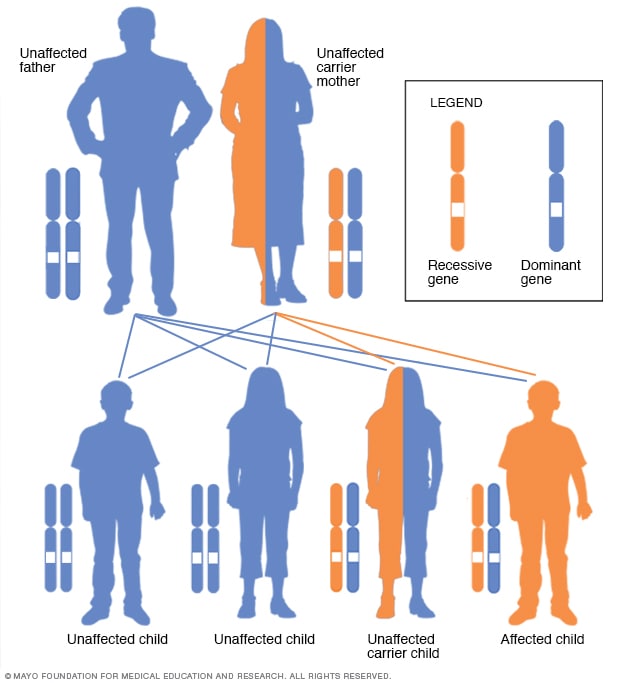Hunter syndrome is a very rare, inherited genetic disorder caused by a missing or malfunctioning enzyme. In Hunter syndrome, the body doesn’t have enough of the enzyme iduronate 2-sulfatase. This enzyme’s job is to break down certain complex molecules, and without enough of this enzyme, the molecules build up in harmful amounts.
The buildup of massive amounts of these harmful substances eventually causes permanent, progressive damage affecting appearance, mental development, organ function and physical abilities.
Hunter syndrome is far more common in boys. The condition is one type of a group of inherited metabolic disorders called mucopolysaccharidoses (MPSs). Hunter syndrome is also known as MPS II.
There’s no cure for Hunter syndrome. Treatment involves managing symptoms and complications.
Hunter syndrome symptoms vary and range from mild to severe. Symptoms aren’t present at birth, but often begin around ages 2 to 4 as the harmful molecules build up.
Signs and symptoms may include:
Hunter syndrome is very uncommon, but if you notice changes in your child’s facial appearance, a loss of previously acquired skills, or other signs or symptoms listed above, talk to your child’s primary care doctor. He or she can help you decide if you need to see a specialist or seek further testing.
Hunter syndrome develops when a defective chromosome is inherited from the child’s mother.
Because of that defective chromosome, an enzyme that’s needed to break down complex sugar molecules is missing or malfunctioning. Without this enzyme, massive amounts of these complex sugar molecules collect in the cells, blood and connective tissues, causing permanent and progressive damage.
 X-linked inheritance pattern with carrier motherOpen pop-up dialog box
X-linked inheritance pattern with carrier motherOpen pop-up dialog box
There are two major risk factors for developing Hunter syndrome:
A variety of complications can occur with Hunter syndrome depending on the type and severity of the disease. Complications can affect the lungs, heart, joints, connective tissue, and brain and nervous system.
An enlarged tongue, thickened gums, and thickening of the nasal passages and windpipe (trachea) make breathing difficult. Children often have chronic ear and sinus infections, respiratory infections, and pneumonia.
Sleep apnea, a condition in which breathing is intermittently interrupted during sleep, is often present because of airway constriction.
Thickening of heart tissue can cause improper closing of heart valves. As a result, the heart and other parts of the body don’t receive blood efficiently. As the disease progresses, these conditions often become worse and typically result in heart failure.
The thickening of tissue can also cause narrowing of the aorta and other blood vessels. This in turn can result in high blood pressure and narrowing of arteries in the lungs.
The storage of undigested complex sugar molecules in connective tissues results in abnormalities in bones, joints and ligaments. This reduces your child’s growth, causing pain and physical malformations and making it difficult for him or her to move.
Joint stiffness is caused by swelling of joint connective tissues and abnormalities of cartilage and bones. If your child is in pain, he or she will likely move less, which can lead to more stiffness and pain.
The group of abnormalities typically seen in the bones of people with Hunter syndrome is called dysostosis multiplex. Children with these abnormalities can develop irregularly shaped vertebrae and spines, ribs, arms, fingers, legs, and pelvises.
Bone abnormalities may cause many people with Hunter syndrome to be abnormally short. Those with milder cases may reach normal or near-normal height.
Hernias are common in Hunter syndrome. A hernia occurs when soft tissue, usually part of the intestine, pokes through a weak spot or tear in the lower abdominal wall.
Hernias associated with Hunter syndrome can become quite large and are often one of the first signs of the disorder. Enlargement of the liver and spleen may increase pressure in the abdomen, causing a hernia.
A variety of neurological complications may be present and continue to develop in children with Hunter syndrome.
Many neurological problems are caused by buildup of excess fluids in your child’s brain. Pressure from these fluids can cause other problems that may cause severe headaches, interfere with vision and change your child’s mental state.
Your child may also develop a condition in which the membranes that surround the spinal cord may become thick and scarred. This causes pressure and compression of the upper spinal cord. As a result, your child may develop fatigue in his or her legs and gradually weaken and become less physically active.
Other disorders, such as carpal tunnel syndrome, can result from nerve compression that happens because of bone deformities and storage of complex sugar molecules in tissues.
Abnormal behavior can develop in children with more-severe cases of Hunter syndrome. Often your child’s mental development will become affected between the ages of 2 and 6.
Some children are hyperactive and have trouble paying attention or following directions. Your child may also behave aggressively and seem unable to sense danger. As your child’s overall physical functioning declines, these behavior problems tend to become less severe.
Seizures also may occur in children with Hunter syndrome.
Recovery times from normal childhood illnesses may be longer for children with Hunter syndrome. As a result, be sure to take general preventive measures — for example, get your child a flu shot and ensure your child receives all necessary vaccinations.
Hunter syndrome is a genetic disorder. Talk to your doctor or a genetic counselor if you’re thinking about having children and you or any members of your family have a genetic disorder or a family history of genetic disorders.
If you think you might be a carrier, genetic tests are available. If you already have a child with Hunter syndrome, you may wish to seek the advice of a doctor or genetic counselor before you have more children.